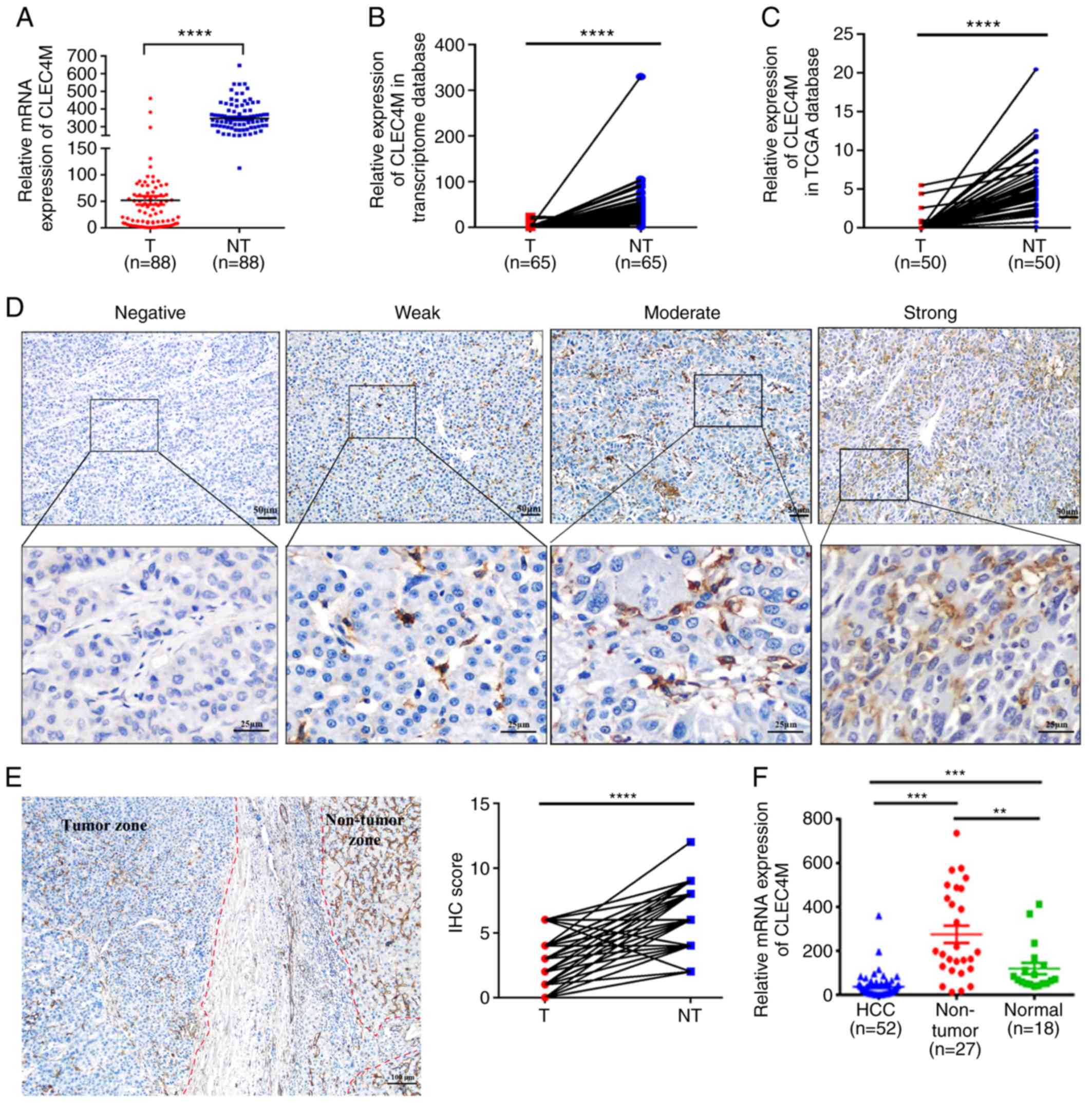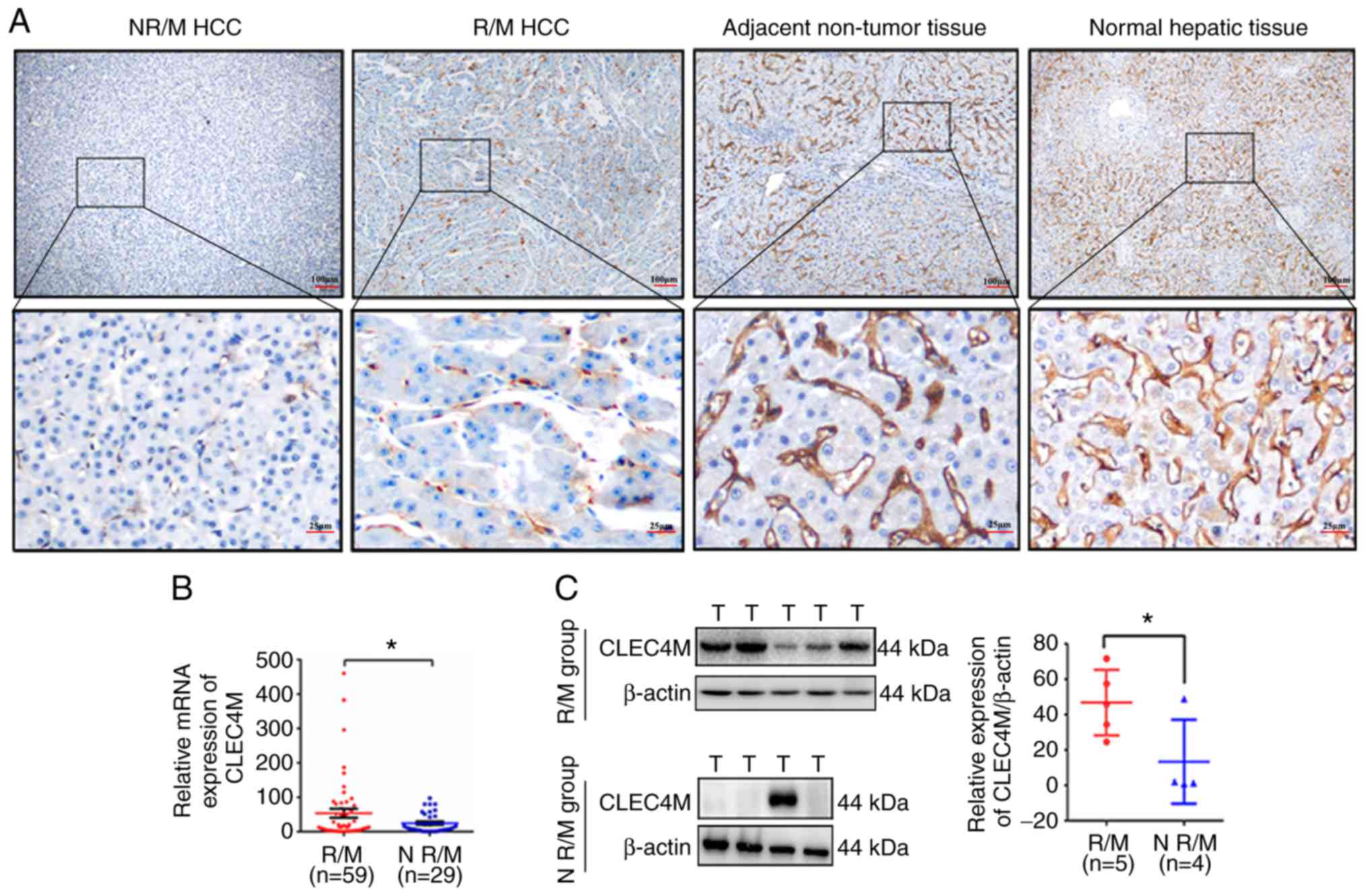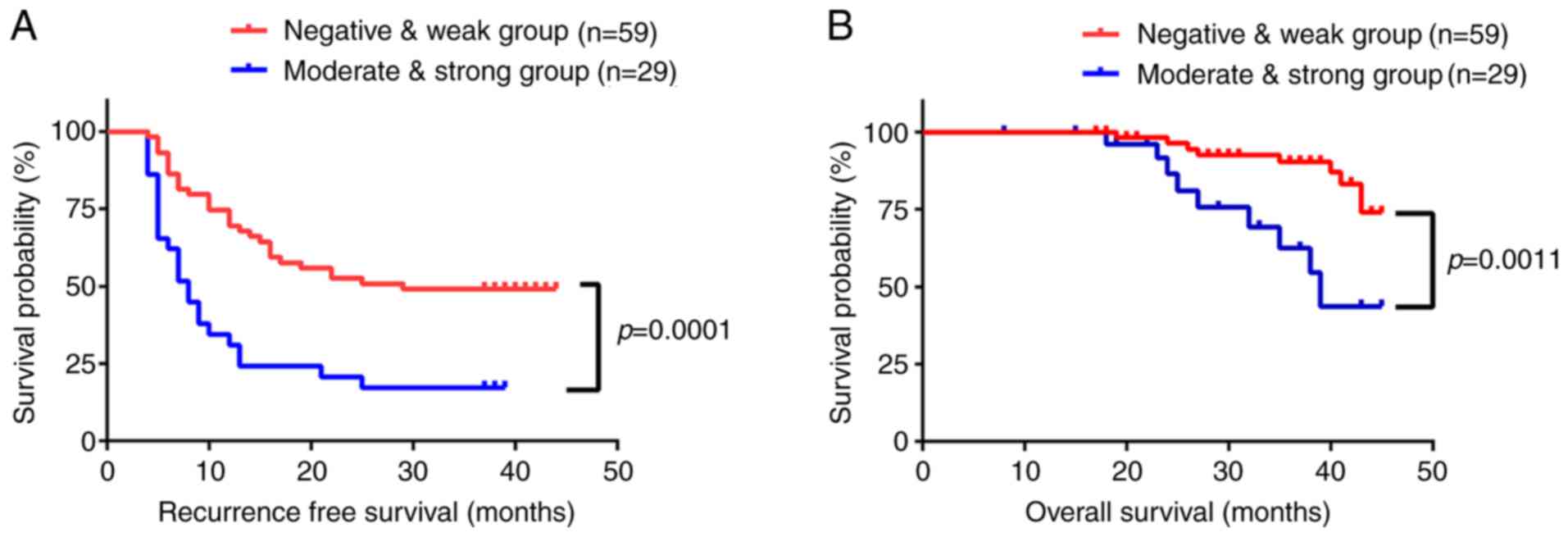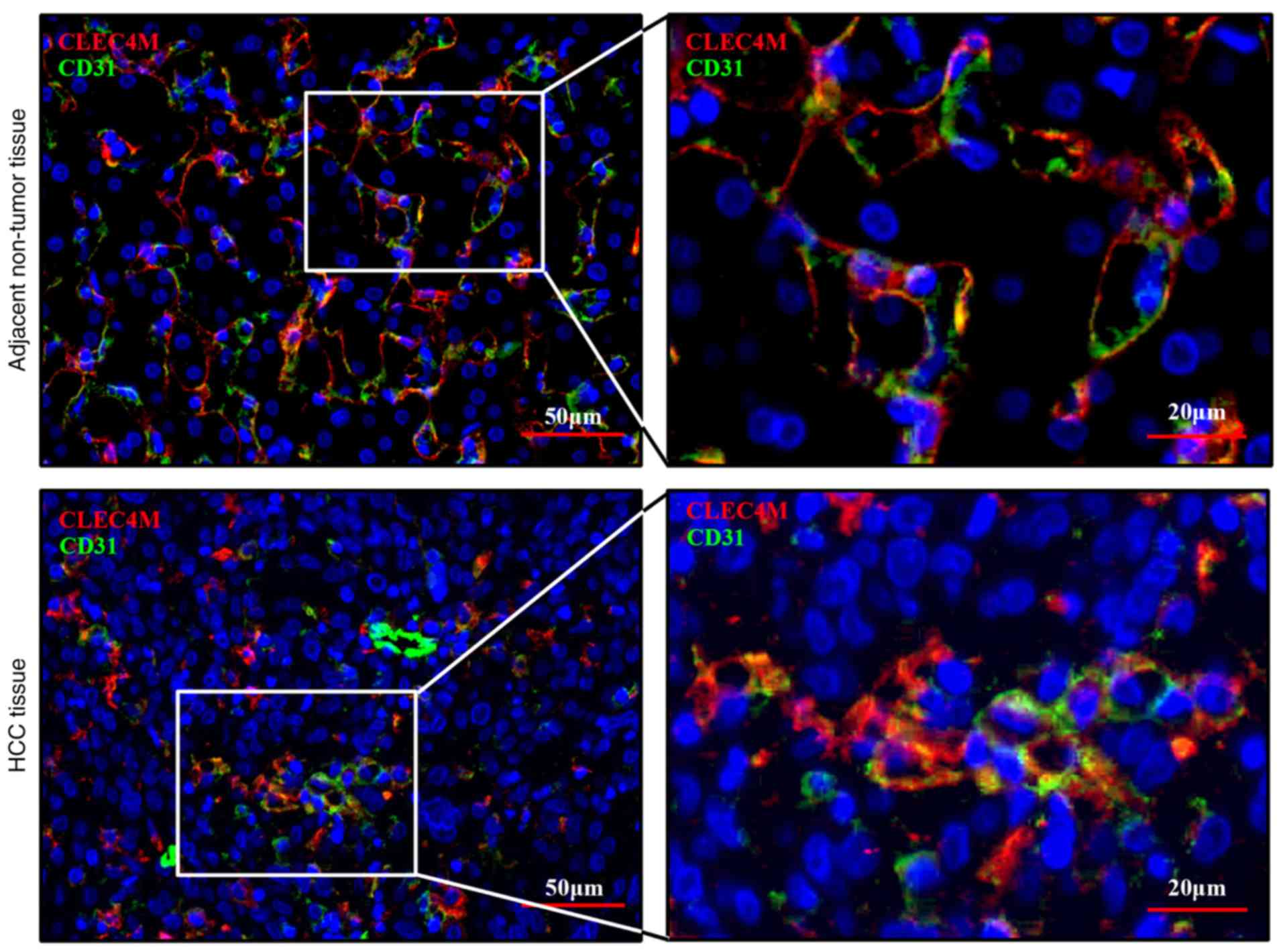|
1
|
Bray F, Ferlay J, Soerjomataram I, Siegel
RL, Torre LA and Jemal A: Global cancer statistics 2018: GLOBOCAN
estimates of incidence and mortality worldwide for 36 cancers in
185 countries. CA Cancer J Clin. 68:394–424. 2018. View Article : Google Scholar : PubMed/NCBI
|
|
2
|
Zhu ZX, Huang JW, Liao MH and Zeng Y:
Treatment strategy for hepatocellular carcinoma in China:
Radiofrequency ablation versus liver resection. Jpn J Clin Oncol.
46:1075–1080. 2016.PubMed/NCBI
|
|
3
|
Zhao LY, Huo RR, Xiang X, Torzilli G,
Zheng MH, Yang T, Liang XM, Huang X, Tang PL, Xiang BD, et al:
Hepatic resection for elderly patients with hepatocellular
carcinoma: A systematic review of more than 17,000 patients. Expert
Rev Gastroenterol Hepatol. 12:1059–1068. 2018. View Article : Google Scholar : PubMed/NCBI
|
|
4
|
Zhao Y, Wang M, Cui C, Zhang L, Liao F, Li
H and Wu X: Significance of combined tests of serum golgi
glycoprotein 73 and other biomarkers in diagnosis of small primary
hepatocellular carcinoma. Cancer Biomark. 15:677–683. 2015.
View Article : Google Scholar : PubMed/NCBI
|
|
5
|
Johnson PJ: The role of serum
alpha-fetoprotein estimation in the diagnosis and management of
hepatocellular carcinoma. Clin Liver Dis. 5:145–159. 2001.
View Article : Google Scholar : PubMed/NCBI
|
|
6
|
Amr KS, Elmawgoud Atia HA, Elazeem
Elbnhawy RA and Ezzat WM: Early diagnostic evaluation of miR-122
and miR-224 as biomarkers for hepatocellular carcinoma. Genes Dis.
4:215–221. 2017. View Article : Google Scholar : PubMed/NCBI
|
|
7
|
Ding D, Yao Y, Zhang S, Su C and Zhang Y:
C-type lectins facilitate tumor metastasis. Oncol Lett. 13:13–21.
2017. View Article : Google Scholar : PubMed/NCBI
|
|
8
|
Dambuza IM and Brown GD: C-type lectins in
immunity: Recent developments. Curr Opin Immunol. 32:21–27. 2015.
View Article : Google Scholar : PubMed/NCBI
|
|
9
|
Ferroni P, Roselli M, Spila A,
D'Alessandro R, Portarena I, Mariotti S, Palmirotta R, Buonomo O,
Petrella G and Guadagni F: Serum sE-selectin levels and
carcinoembryonic antigen mRNA-expressing cells in peripheral blood
as prognostic factors in colorectal cancer patients. Cancer.
116:2913–2921. 2010. View Article : Google Scholar : PubMed/NCBI
|
|
10
|
Guo RM, Zhao CB, Li P, Zhang L, Zang SH
and Yang B: Overexpression of CLEC18B associates with the
proliferation, migration, and prognosis of glioblastoma. ASN Neuro.
10:17590914187819492018. View Article : Google Scholar : PubMed/NCBI
|
|
11
|
van Gisbergen KP, Aarnoudse CA, Meijer GA,
Geijtenbeek TB and van Kooyk Y: Dendritic cells recognize
tumor-specific glycosylation of carcinoembryonic antigen on
colorectal cancer cells through dendritic cell-specific
intercellular adhesion molecule-3-grabbing nonintegrin. Cancer Res.
65:5935–5944. 2005. View Article : Google Scholar : PubMed/NCBI
|
|
12
|
Zuo Y, Ren S, Wang M, Liu B, Yang J, Kuai
X, Lin C, Zhao D, Tang L and He F: Novel roles of liver sinusoidal
endothelial cell lectin in colon carcinoma cell adhesion, migration
and in-vivo metastasis to the liver. Gut. 62:1169–1178. 2013.
View Article : Google Scholar : PubMed/NCBI
|
|
13
|
Zhang Y, Zhang Q, Zhang M, Yuan M, Wang Z,
Zhang J, Zhou X, Zhang Y, Lin F, Na H, et al: DC-SIGNR by
influencing the lncRNA HNRNPKP2 upregulates the expression of CXCR4
in gastric cancer liver metastasis. Mol Cancer. 16:782017.
View Article : Google Scholar : PubMed/NCBI
|
|
14
|
Coupland LA, Chong BH and Parish CR:
Platelets and P-selectin control tumor cell metastasis in an
organ-specific manner and independently of NK cells. Cancer Res.
72:4662–4671. 2012. View Article : Google Scholar : PubMed/NCBI
|
|
15
|
Yasmin-Karim S, King MR, Messing EM and
Lee YF: E-selectin ligand-1 controls circulating prostate cancer
cell rolling/adhesion and metastasis. Oncotarget. 5:12097–12110.
2014. View Article : Google Scholar : PubMed/NCBI
|
|
16
|
Pohlmann S, Soilleux EJ, Baribaud F,
Leslie GJ, Morris LS, Trowsdale J, Lee B, Coleman N and Doms RW:
DC-SIGNR, a DC-SIGN homologue expressed in endothelial cells, binds
to human and simian immunodeficiency viruses and activates
infection in trans. Proc Natl Acad Sci USA. 98:2670–2675. 2001.
View Article : Google Scholar : PubMed/NCBI
|
|
17
|
Soilleux EJ, Morris LS, Leslie G, Chehimi
J, Luo Q, Levroney E, Trowsdale J, Montaner LJ, Doms RW, Weissman
D, et al: Constitutive and induced expression of DC-SIGN on
dendritic cell and macrophage subpopulations in situ and in vitro.
J Leukoc Biol. 71:445–457. 2002.PubMed/NCBI
|
|
18
|
da Silva RC, Segat L, Zanin V, Arraes LC
and Crovella S: Polymorphisms in DC-SIGN and L-SIGN genes are
associated with HIV-1 vertical transmission in a Northeastern
Brazilian population. Hum Immunol. 73:1159–1165. 2012. View Article : Google Scholar : PubMed/NCBI
|
|
19
|
Chen PC, Chuang PK, Chen CH, Chan YT, Chen
JR, Lin SW, Ma C, Hsu TL and Wong CH: Role of N-linked glycans in
the interactions of recombinant HCV envelope glycoproteins with
cellular receptors. ACS Chem Biol. 9:1437–1443. 2014. View Article : Google Scholar : PubMed/NCBI
|
|
20
|
Op den Brouw ML, de Jong MA, Ludwig IS,
van der Molen RG, Janssen HL, Geijtenbeek TB and Woltman AM:
Branched oligosaccharide structures on HBV prevent interaction with
both DC-SIGN and L-SIGN. J Viral Hepat. 15:675–683. 2008.
View Article : Google Scholar : PubMed/NCBI
|
|
21
|
Na H, Liu X, Li X, Zhang X, Wang Y, Wang
Z, Yuan M, Zhang Y, Ren S and Zuo Y: Novel roles of DC-SIGNR in
colon cancer cell adhesion, migration, invasion, and liver
metastasis. J Hematol Oncol. 10:282017. View Article : Google Scholar : PubMed/NCBI
|
|
22
|
Cai Z, Zeng Y, Xu B, Gao Y, Wang S, Zeng
J, Chen L, Huang A, Liu X and Liu J: Galectin-4 serves as a
prognostic biomarker for the early recurrence/metastasis of
hepatocellular carcinoma. Cancer Sci. 105:1510–1517. 2014.
View Article : Google Scholar : PubMed/NCBI
|
|
23
|
Remmele W, Hildebrand U, Hienz HA, Klein
PJ, Vierbuchen M, Behnken LJ, Heicke B and Scheidt E: Comparative
histological, histochemical, immunohistochemical and biochemical
studies on oestrogen receptors, lectin receptors, and Barr bodies
in human breast cancer. Virchows Arch A Pathol Anat Histopathol.
409:127–147. 1986. View Article : Google Scholar : PubMed/NCBI
|
|
24
|
Livak KJ and Schmittgen TD: Analysis of
relative gene expression data using real-time quantitative PCR and
the 2(-Delta Delta C(T)) method. Methods. 25:402–408. 2001.
View Article : Google Scholar : PubMed/NCBI
|
|
25
|
Dobin A, Davis CA, Schlesinger F, Drenkow
J, Zaleski C, Jha S, Batut P, Chaisson M and Gingeras TR: STAR:
Ultrafast universal RNA-seq aligner. Bioinformatics. 29:15–21.
2013. View Article : Google Scholar : PubMed/NCBI
|
|
26
|
Speir ML, Zweig AS, Rosenbloom KR, Raney
BJ, Paten B, Nejad P, Lee BT, Learned K, Karolchik D, Hinrichs AS,
et al: The UCSC Genome Browser database: 2016 update. Nucleic Acids
Res. 44:D717–D725. 2016. View Article : Google Scholar : PubMed/NCBI
|
|
27
|
Crouch EE and Doetsch F: FACS isolation of
endothelial cells and pericytes from mouse brain microregions. Nat
Protoc. 13:738–751. 2018. View Article : Google Scholar : PubMed/NCBI
|
|
28
|
Lai WK, Sun PJ, Zhang J, Jennings A, Lalor
PF, Hubscher S, McKeating JA and Adams DH: Expression of DC-SIGN
and DC-SIGNR on human sinusoidal endothelium: A role for capturing
hepatitis C virus particles. Am J Pathol. 169:200–208. 2006.
View Article : Google Scholar : PubMed/NCBI
|
|
29
|
Chen Y, Gao SG, Chen JM, Wang GP, Wang ZF,
Zhou B, Jin CH, Yang YT and Feng XS: Risk factors for the long-term
efficacy, recurrence, and metastasis in small hepatocellular
carcinomas. Cell Biochem Biophys. 72:627–631. 2015. View Article : Google Scholar : PubMed/NCBI
|
|
30
|
Borentain P, Carmona S, Mathieu S, Jouve
E, El-Battari A and Gerolami R: Inhibition of E-selectin expression
on the surface of endothelial cells inhibits hepatocellular
carcinoma growth by preventing tumor angiogenesis. Cancer Chemother
Pharmacol. 77:847–856. 2016. View Article : Google Scholar : PubMed/NCBI
|
|
31
|
Bogoevska V, Horst A, Klampe B, Lucka L,
Wagener C and Nollau P: CEACAM1, an adhesion molecule of human
granulocytes, is fucosylated by fucosyltransferase IX and interacts
with DC-SIGN of dendritic cells via Lewis × residues. Glycobiology.
16:197–209. 2006. View Article : Google Scholar : PubMed/NCBI
|
|
32
|
Koch AE, Halloran MM, Haskell CJ, Shah MR
and Polverini PJ: Angiogenesis mediated by soluble forms of
E-selectin and vascular cell adhesion molecule-1. Nature.
376:517–519. 1995. View
Article : Google Scholar : PubMed/NCBI
|
|
33
|
Bashirova AA, Geijtenbeek TB, van
Duijnhoven GC, van Vliet SJ, Eilering JB, Martin MP, Wu L, Martin
TD, Viebig N, Knolle PA, et al: A dendritic cell-specific
intercellular adhesion molecule 3-grabbing nonintegrin
(DC-SIGN)-related protein is highly expressed on human liver
sinusoidal endothelial cells and promotes HIV-1 infection. J Exp
Med. 193:671–678. 2001. View Article : Google Scholar : PubMed/NCBI
|
|
34
|
Falkowska E, Durso RJ, Gardner JP, Cormier
EG, Arrigale RA, Ogawa RN, Donovan GP, Maddon PJ, Olson WC and
Dragic T: L-SIGN (CD209L) isoforms differently mediate
trans-infection of hepatoma cells by hepatitis C virus
pseudoparticles. J Gen Virol. 87:2571–2576. 2006. View Article : Google Scholar : PubMed/NCBI
|
|
35
|
Brunt EM, Gouw AS, Hubscher SG, Tiniakos
DG, Bedossa P, Burt AD, Callea F, Clouston AD, Dienes HP, Goodman
ZD, et al: Pathology of the liver sinusoids. Histopathology.
64:907–920. 2014. View Article : Google Scholar : PubMed/NCBI
|
|
36
|
Patten DA, Wilson GK, Bailey D, Shaw RK,
Jalkanen S, Salmi M, Rot A, Weston CJ, Adams DH and Shetty S: Human
liver sinusoidal endothelial cells promote intracellular crawling
of lymphocytes during recruitment: A new step in migration.
Hepatology. 65:294–309. 2017. View Article : Google Scholar : PubMed/NCBI
|
|
37
|
Koppel EA, van Gisbergen KP, Geijtenbeek
TB and van Kooyk Y: Distinct functions of DC-SIGN and its
homologues L-SIGN (DC-SIGNR) and mSIGNR1 in pathogen recognition
and immune regulation. Cell Microbiol. 7:157–165. 2005. View Article : Google Scholar : PubMed/NCBI
|
|
38
|
Liu X, Zhang H, Su L, Yang P, Xin Z, Zou
J, Ren S and Zuo Y: Low expression of dendritic cell-specific
intercellular adhesion molecule-grabbing nonintegrin-related
protein in lung cancer and significant correlations with brain
metastasis and natural killer cells. Mol Cell Biochem. 407:151–160.
2015. View Article : Google Scholar : PubMed/NCBI
|
|
39
|
Wang X, Jiang Y, Yuan M, Chen C, Wang K,
Zhang Q, Zuo Y and Ren S: Overexpression of dendritic cell-specific
intercellular adhesion molecule-3-grabbing nonintegrin-related
protein in cervical cancer and correlation with squamous cell
carcinoma antigen. Oncol Lett. 14:2813–2821. 2017. View Article : Google Scholar : PubMed/NCBI
|


















